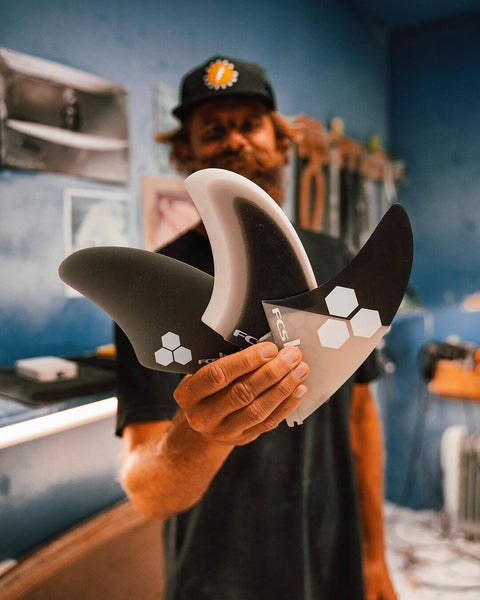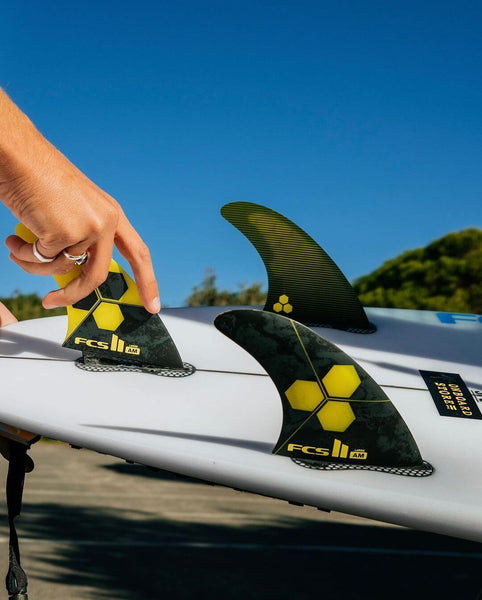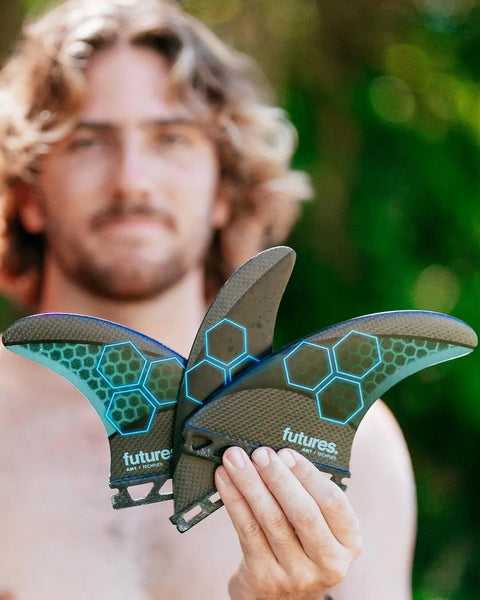How to Surf Better Part 7 of 9: Choosing the Right Fins
Share
Once you have chosen the right board for the conditions and your abilities, it is important to also match that board with the right fins. There are four main fin clusters that are used on surfboards, ranging from single fins (slowest and most “retro,” but provide a lot of hold and a classic feel) and single fins (also retro, but faster and looser) to thrusters (modern three-fin setup) and quads (a modern tweak on the twin fin, which includes trailing fins on each side).
Generally speaking, single fins are slowest and least maneuverable, but provide the most hold while trimming down the line; twin fins are fastest but loosest and don’t really cater to top-to-bottom surfing; quads are slightly slower than twins, but provide extra control off the bottom and are a bit more high performance; and thrusters are the ultimate compromise, providing more control and maneuverability, but sacrificing some of the speed of twins and quads due to the drag of the center fin.
Alternative Fin Setups
One alternative that we have had a lot of fun with recently is the 2+1 setup, which can be used to bridge the gap between the high performance thruster and the classic feel of a single fin. Featuring a larger fin in the center and normal sized side fins, the 2+1 provides a bit more control off the bottom, but is harder to throw around in sliding maneuvers and a little slower rail to rail.

The opposite of the 2+1 is a twin fin with a center stabilizer. This setup is great for smaller waves and grovelers, as it has the speed and drive generated by the large twin side fins, but also a bit of extra control provided by the small stabilizer in the center (which doesn’t create as much drag as a normal sized thruster center fin, and thus doesn’t slow the board down as much. When you need to create your own speed because the wave doesn’t provide much, but still want to rip, this reverse 2+1 setup is the way to go.
Fin Size and Wave Size
As counterintuitive as it sounds, you typically want to go with larger fins in smaller waves, as they tend to create more drive and speed due to the wide base of the side fins and the water that they propel between them. The caveat here is that a larger center fin will slow the board down—so the benefit of larger fins is definitely centered around the side skegs. Another thing to keep in mind is that although larger fins will provide more drive, they will also require a larger turning radius, which means they aren’t quite as snappy and responsive through turns. As always, you want to look for a balance between generating speed and having a board that’s loose enough to rip.

In larger, more powerful surf, speed is less of an issue, so it’s possible to ride smaller fins. However, it’s important not to go too small, as you don’t want to slide out in critical sections or during big bottom turns or barrels. Fins are typically sized according to weight, so take a look at the scale provided by your fin company and make sure that you are within the appropriate range.
Modern Fin Templates
There are three basic types of modern fin templates—neutral, pivot, and carve. Carve (or rake) fins have more drawn-back rake and a wider base, which makes them better for big, drawn-out carves in larger, more powerful waves. Pivot fins, on the other hand, tend to be oriented a bit more vertically, which less rake, which results in a tighter turning radius, particularly in a hollow pocket. Finally, neutral fins are a compromise between carve and pivot fins, and tend to be the best all-around option.

Regardless of what fin setup, size, and style you end up using, the important thing is to keep an open mind and a fresh perspective. The right set of fins can turn a bad board into a magic one, but the wrong set can have you spinning out during turns or bogging due to lack of speed. Experiment until you get it right, but bear in mind that no one fin is perfect for all boards and all conditions.
Have fun!
SHOP YOUR FINS HERE
More Articles👈
HOW TO CHOOSE THE RIGHT FIN SIZE FOR LONGBOARDS?
YOUR GUIDE TO FCS II CARVER FIN FAMILY
HOW TO CHOOSE FUTURES FINS - THE CHOICE OF PROS AND AMATEURS ALIKE
